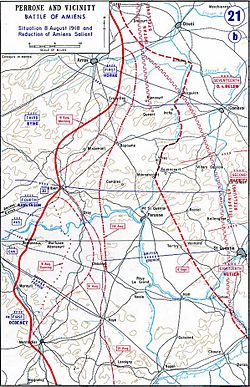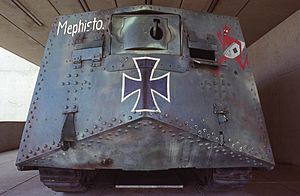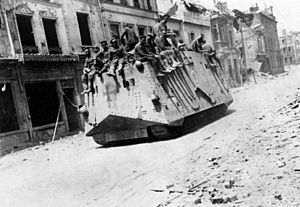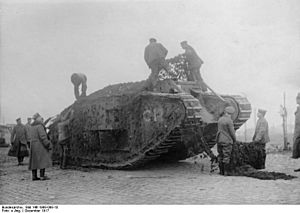Second Battle of Villers-Bretonneux facts for kids
Quick facts for kids Second Battle of Villers-Bretonneux |
|||||||
|---|---|---|---|---|---|---|---|
| Part of Operation Michael (German spring offensive) | |||||||
 1918 map showing vicinity of Villers-Bretonneux |
|||||||
|
|||||||
| Belligerents | |||||||
| Commanders and leaders | |||||||
| Strength | |||||||
| Australian 13th, 14th and 15th Brigades 173rd Brigade of British 58th Division Remnants of British 8th Division Moroccan Division 3 Mark IV tanks (one male, two female) 7 Medium Mark A Whippet tanks |
228th Infantry Division 4th Guards Infantry Division 13 A7V tanks |
||||||
| Casualties and losses | |||||||
| c. 10,400 | |||||||
The Second Battle of Villers-Bretonneux was a major fight during the First World War. It happened from April 24 to 27, 1918, near the town of Villers-Bretonneux in France. This battle is famous because it was the first time that tanks fought against each other in history! It was also the biggest and most successful tank attack by the German army in the war.
In this battle, three German A7V tanks faced off against three British Mark IV tanks. Two of the British tanks were "female" tanks, meaning they only had machine guns. These two tanks were damaged and had to pull back. But the third British tank, a "male" tank with bigger guns, hit and stopped a German A7V. The German crew then left their tank. The British "male" tank kept fighting the other two German tanks, which also retreated. Later, the "male" tank was hit by artillery and its crew had to leave it.
After the tank battle, Australian and British soldiers launched a counter-attack. They surrounded Villers-Bretonneux on the night of April 24. The town was taken back on April 25. On April 26, the French Moroccan Division played a key role in pushing back the German forces. By April 27, the Allied forces (Australia, Britain, and France) had almost returned the battle lines to where they were before the German attack.
Contents
Why the Battle Happened: The German Spring Offensive
In late 1917 and early 1918, the war on the Eastern Front ended. This allowed Germany to move many soldiers and a lot of equipment to the Western Front. Germany's commander, Erich Ludendorff, knew that the United States was joining the war. He wanted to attack quickly before the U.S. soldiers arrived and made the Allies stronger.
In March 1918, Germany launched a huge attack called the Spring Offensive. They attacked the British Third and Fifth Armies in the Somme area. These British armies were not at full strength.
The German attack was very strong, with heavy bombs and gas. The British Fifth Army was quickly pushed back. The important railway hub at Amiens was in danger of being captured. If Amiens fell, it would be a big win for Germany. The Allies sent more soldiers to the Somme front. By the end of May, the German advance was stopped near Hamel.
Fighting for Villers-Bretonneux
In early April, the Germans attacked again. They tried to capture Villers-Bretonneux, a town on high ground. From this high ground, German artillery could see and bomb Amiens, which was only about 16 kilometers (10 miles) away. This made Villers-Bretonneux very important.
On April 4, the Germans tried to take the town with 15 divisions of soldiers. But British and Australian troops, with help from Canadians, stopped them in the First Battle of Villers-Bretonneux. After this first battle, the British 8th Division held the area around Villers-Bretonneux. This division had lost many soldiers in earlier German attacks.
The Battle Begins: German Attack and Tank Fight
On the night of April 17-18, the Germans used mustard gas to bomb the area behind Villers-Bretonneux. This caused about 1,000 Australian soldiers to become sick. On the night of April 23-24, the Germans fired more artillery, using both mustard gas and powerful explosives.
The next morning, April 24, the Germans attacked Villers-Bretonneux with four divisions and 13 A7V tanks. They broke through the British 8th Division, creating a 3-kilometer (2-mile) wide gap in the Allied line. Villers-Bretonneux fell to the Germans, and Amiens was again in danger.
The First Tank-on-Tank Battle
After the Germans took Villers-Bretonneux, the first ever tank battle happened. Three British Mark IV tanks from the Tank Corps were sent to stop the German advance.
- One was a "male" tank, commanded by Lieutenant Frank Mitchell. It had two powerful 6-pounder guns and machine guns. Only four of its usual eight crew members were present because the others had been gassed.
- The other two were "female" tanks, armed only with machine guns, mainly for fighting infantry.
As these British tanks moved forward, they met a German A7V tank named "Nixe." "Nixe" fired at the two "female" tanks, damaging them and forcing them to retreat. Their machine guns could not break through the German tank's armor.
Lieutenant Mitchell's "male" Mark IV tank kept firing at "Nixe" while moving to avoid German artillery. It was hard to aim while moving, so Mitchell's tank stopped. His gunner then hit "Nixe" three times. "Nixe" tipped over, possibly because it was on a slope. The German crew, including their commander, left the tank. The British fired at them as they ran, killing nine.
Mitchell's tank then faced two more German A7Vs, supported by infantry. The British tank fired some shots, and the German tanks retreated. Mitchell's tank then attacked the German infantry.
Seven new British Whippet light tanks arrived. They attacked the Germans, who were gathering in the open. The Whippets killed many German soldiers with their machine guns and by running them over. Mitchell later said their tank tracks were covered with blood when they returned. Only four of the seven Whippets came back; the others were destroyed by artillery.
Mitchell's Mark IV tank was the last one on the field and was moving slowly. It became a target for German artillery. Mitchell ordered his tank back, but a mortar shell hit its tracks, disabling it. The crew left the tank and escaped to a British trench.
The German crew of "Nixe" tried to get back into their tank and return to their base, but its engines failed. The Germans tried to get it back but failed, so they blew it up on the night of April 23-24. Earlier that day, another German A7V tank, "Mephisto" (No. 506), got stuck in a hole and was left by its crew. British and Australian soldiers found it three months later. It is now the only surviving German World War I tank and is kept at the Queensland Museum in Australia.

Allied Counter-Attack to Retake the Town
Around noon, British soldiers from the 1st Battalion of the Sherwood Foresters tried a counter-attack. General Henry Rawlinson quickly ordered a larger counter-attack. He wanted the Australian 13th Brigade and 15th Brigade to attack. The 13th Brigade had already suffered many losses.
Rawlinson planned to surround the town: the 15th Brigade would attack north of the town, and the 13th Brigade would attack south. British troops would support them. There was no artillery bombardment before the attack to keep it a surprise. Instead, artillery would bomb the town for an hour once the attack started.
The attack began on the night of April 24-25. German machine gunners caused many Australian casualties. However, Australian soldiers bravely charged the machine-gun posts. Lieutenant Clifford Sadlier of the 51st Battalion even won the Victoria Cross for attacking with hand-grenades.
The two Australian brigades swept around Villers-Bretonneux. The Germans retreated, becoming surrounded in the town. British units attacked from the front. By April 25, the town was recaptured and given back to its people. This was a big success for the Allies. They stopped the German attempt to capture Amiens and took back Villers-Bretonneux, even though they were outnumbered. The village stayed in Allied hands until the end of the war.
The Moroccan Division's Important Role
The French Moroccan Division played a very important part in the Second Battle of Villers-Bretonneux. On April 26, they attacked south of the town and helped the Australian 51st and 52nd Battalions.
Even though it was costly, the Moroccan Division's attack was a success. They pushed the battle line further east than the Australian troops had been able to. The Moroccan Division's help was crucial for the whole operation to succeed. For their bravery, the 8e régiment de marche de zouaves of the Moroccan Division received a Légion d’honneur from the French President. The award praised them for being ready for "all acts of boldness and all sacrifices" and for blocking the road to Amiens.
Aftermath and Memorial
The fighting around Villers-Bretonneux in April 1918 caused many casualties:
- Australian soldiers: 2,473
- British soldiers: 9,529
- French soldiers: about 3,500
- German soldiers: about 8,000–10,400
Villers-Bretonneux Memorial
In the 1930s, a tall memorial was built at the Villers-Bretonneux Military Cemetery. It honors the Australian soldiers who died in France during the First World War. The cemetery is on a hill overlooking Villers-Bretonneux. It contains about 2,000 graves, with 779 of them belonging to Australians.
The victory at Villers-Bretonneux is remembered every year by Australians on the anniversary of the Gallipoli landings. In 2008, for the 90th anniversary, the Australian and New Zealand Anzac Day dawn service was held on Fouilloy Hill for the first time.



